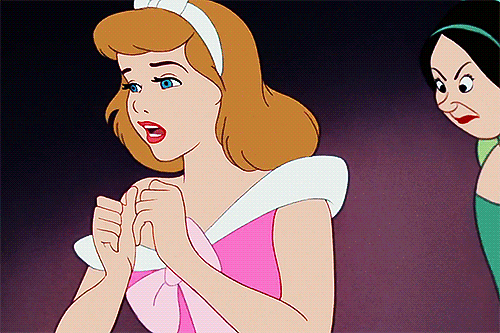Fiction Relationship Analysis: Disney's Cinderella
www.melsmagnificentmusings.com
All images are copyright to Disney and their property
"Cinderella" is a classic fairy tale. Nearly every culture across time and the globe has a version of the story as modified for their own culture. The original story emerged in China, 850 B.C.E. This explains why feet are so prominent, as foot-binding was a common practice amongst women during this time in Chinese culture. The smaller a woman's feet were, the more attractive she was. Part of this is because a woman with small feet were often wealthier; the act of foot-binding was so painful and destructive that they were unable to do many physical activities which showed their elevated status and ability to afford servants who would do the work for them.
While feet are a key aspect of the "Cinderella" fairy tale, there are more vital commonalities that transcend culture and are prevalent in EVERY version and retelling regardless of culture or era. The most prevalent commonalities are the notions that kindness and valor will prevail over deceit and hardships and that those who possess and express these qualities will be rewarded.
The Disney retelling of "Cinderella" is no exception. Cinderella is a kind, young woman who endures the mistreatment and downright abuse of her stepmother and stepsisters with unwavering patience and hope. This is where many misinterpretations are applied. While it is important to apply a modern and progressive lens to art and its representation of society, it's also important to compare it to the initial value and message that is being taught. There are better ways to make a point, of course, but there is a reason "Cinderella" is a story that has traveled so far and across time and culture.
Misinterpretation 1: "Cinderella" is promoting taking a passive approach to abuse
While this claim can be made, when you look at the story I argue that this is a misinterpretation and only a surface judgment. Specifically focusing on Disney's animated film (disregarding "Ever After" and the live-action for the purposes of conciseness,) Cinderella wasn't passive at all. She did her chores and tried to have a positive outlook on a bleak situation, but did never acknowledged that her treatment was "okay" or "normal."
While she endured, she also defended herself and spoke up when it was important. When her stepsisters accused her of a prank by putting Gus in one of their tea cups, she tried to defend herself to her stepmother but wouldn't be heard. She attempted multiple explanations, only to be cut off each time. She didn't admit to something she didn't do, but she also didn't continue to fight a futile battle.
When it came time for the ball, she requested to go. It was important to her and she made it happen, circumventing the obstacles her family put in place to deny her the opportunity. Her hope and work ethic got her through it. She didn't resort to petty arguments that would get her nothing, instead she relied on her skills, integrity, and friends to accomplish what seemed impossible. If she were passive, she never would have requested to go let alone rose to the impossible challenge her stepmother issued her so that she could prove her worth and dignity. When her sisters destroyed her gown, she wasn't passive and didn't just stand there and let it happen. She tried to get away but they blocked her on both sides and she couldn't. She also was visibly upset with her stepmother, understanding it was she who manipulated her stepsisters to attack. Cinderella, again, didn't excuse the behavior nor was she "okay" with it. She fled to her safe place and wept.
Boom, bitch.
Cinderella constantly fought her situation, but she picked her battles wisely and didn't fight with aggression or anger. Her kindness, patience, and good-natured behavior may appear like a passive approach to her abuse, but it is far from it. Instead, her actions and reactions only support that she is kind and honorable with integrity and a strong moral and ethical code which are all the traits that every version of the story told anywhere highlights.Misinterpretation 2: "Cinderella" promotes the damsel in distress stereotype (and that you can meet a man, dance with him, barely talk, and then marry the guy.)
That aside, the modern perception of romantic love gets in the way of the actual message. The prince didn't "save" Cinderella—technically, the mice and birds did—he was her reward. It wasn't that she was the damsel in distress, I didn't see the prince run upstairs and free her from her locked room, did you? No. She got herself out of the situation by making friends and connections whom she could rely on. On top of that, she saved herself by providing the other slipper and proving she was the woman he was seeking. In your face step-family! (Again, another example of her not being passive.)
Just stand there and look pretty, Princey
Misinterpretation 3: Outer beauty is what matters
Obviously, Disney has done a lot over the recent decades to try and create female characters who are more than their appearance and whose physical beauty is rarely even acknowledged let alone a factor in their story (Mulan, Moana, Brave, etc.) However, Cinderella was created in the 1950's and the feminist movements of the 70's, 90's, and 2010's hadn't happened yet. Due to the culture and time period it was created in, yes, there is a bit more focus on her beauty and poise being what attracts the prince. This was later rectified in films with longer run times such as "Ever After" and Disney's live-action version.That said, even in the animated film that was never really the point. In the original fairy tale it was a consistent theme that she was beautiful and her evil stepsisters would make her sleep in the fireplace, getting covered with cinder ash, to minimize her beauty. Once she was freed of their grasp, and with her fairy godmother's help, her true beauty could shine through and she no longer had to hide who she was because of her abusers. Looking at it through this context, her outer beauty is a mere reflection of her inner beauty and it is that which attracts the prince because—remember?—he's her reward for being a kind, good-natured person.
Everyone knows a little glitter fixes years of abuse and neglect
When working with a visual, animated format in the 1950's it was difficult to translate "he's attracted to her inner beauty because she's such a wonderful person" with a glance and a 74 minute run-time. As mentioned earlier, Disney figured out how to fix that issue with the live-action version where they allowed the prince and Cinderella to have a few on-screen conversations to get to know each other. It's important to mention that the culture of the 1950's was much less "in your face" about these interactions and messages as our culture is today. In the 50's, courtship and romance was meant to be discrete and portrayed as a subtle smile, a dance, a lingering gaze—not as we expect to see it now through witty banter, conversation, and some passionate shouting. But, considering the prince is simply an object of her reward, it doesn't really matter if he gets to know her in the animated version since that was never the point of his character or presence.
and kind demeanor is so attractive
that no one else at the ball can compare
to your kind soul
A lot of Disney's earlier animated princess movies get heavy criticism now that our culture has changed our expectations and demands for female characters and representation (which is super awesome and I love the new direction Disney is going with their princess films and how they are adding more substance to their earlier ones in the live-action remakes to address some of the earlier issues with characterization and plot) but not all of it is deserving. When you consider the source material and the lesson that was meant to be gained from the fairy tale, Disney actually stuck to it pretty well. The issue is when the audience loses sight of the actual message and lesson and begins to only identify the differences between their expectations now vs what was acceptable in the 1950's.
The point of Cinderella is to be a kind person and to not allow external hardships compromise your inner integrity. When the viewer remembers this, Cinderella is actually an excellent role model for everyone. She knows she is being mistreated but she endures it the best she can while she has to, not allowing it to make her angry or bitter or hurtful toward others, and the moment she gets her chance to better her life and situation she takes it. She fights within her means and is eventually rewarded for her good nature, kindness, and endurance.

